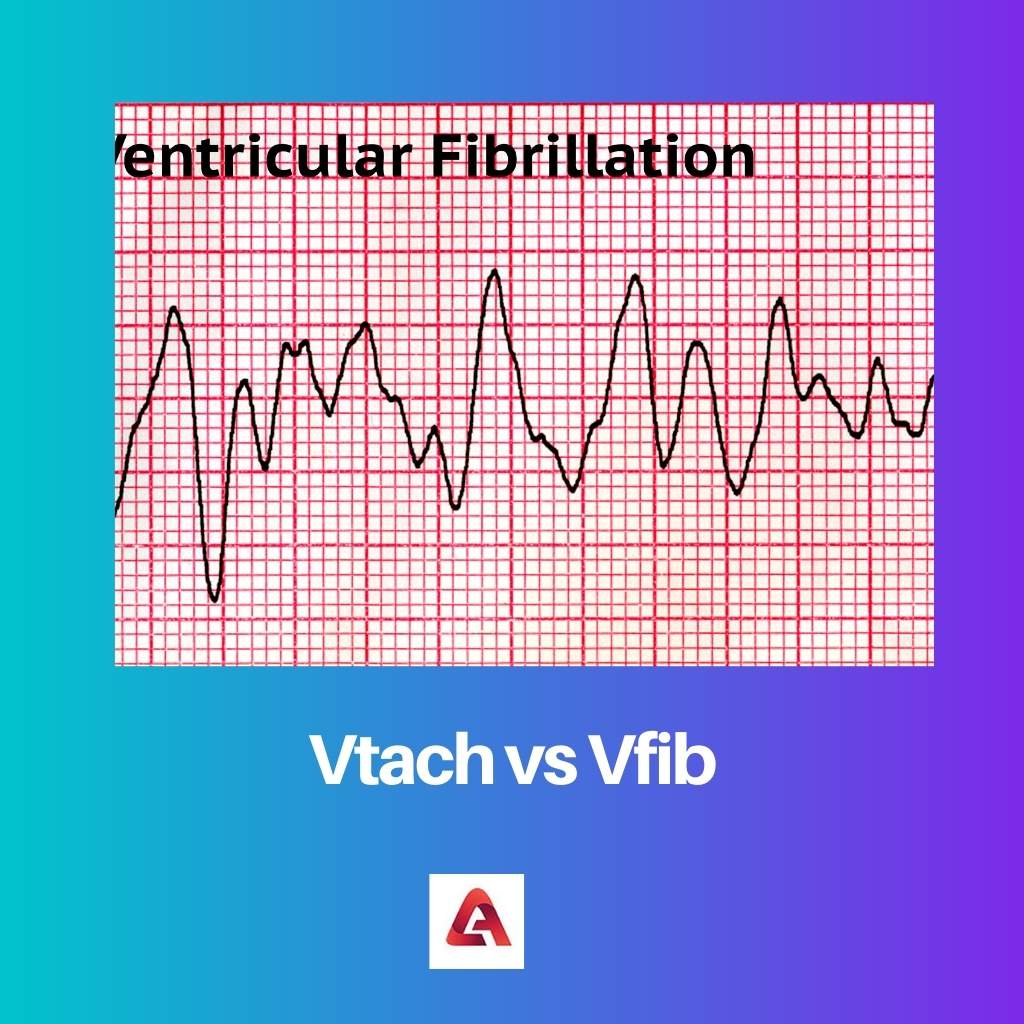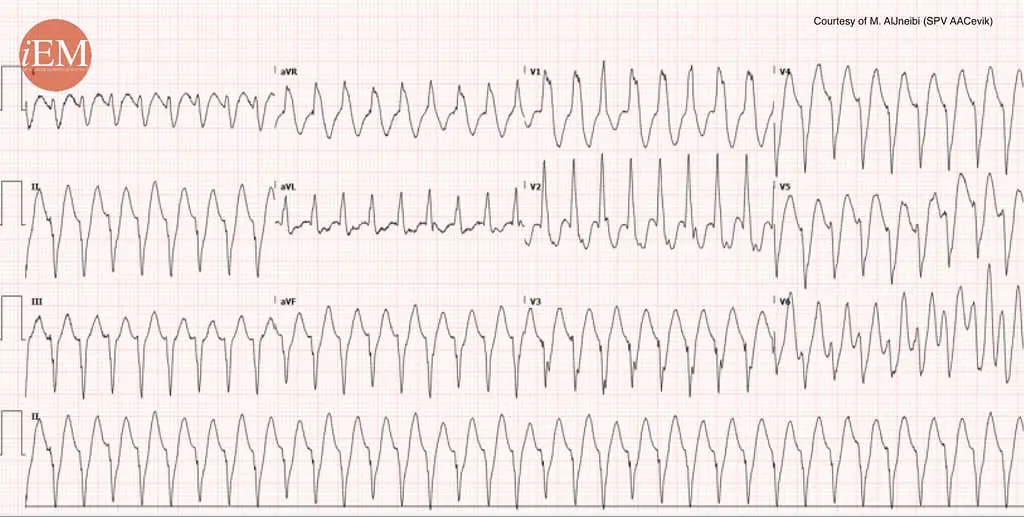Vtach and Vfib are similar conditions that arise when a person’s heartbeat or heart count gets irregular or unusual. Either it would be too fast or too slow.
Vtach is termed Ventricular Tachycardia; on the other side, Vfib is termed Ventricular Fibrillation. Both of these conditions are somehow the result of abnormal heart rhythm, also called heart arrhythmia.
Key Takeaways
- VTach (ventricular tachycardia) is characterized by a fast but regular heart rate, while VFib (ventricular fibrillation) involves rapid, erratic heartbeats.
- VTach may lead to VFib if not treated promptly, and both can be life-threatening.
- Treatment for VTach includes medications, implantable cardioverter-defibrillators (ICDs), or catheter ablation, while VFib requires immediate CPR and defibrillation.
Vtach vs Vfib
VTach is a rapid heart rhythm caused by heart disease, scarring, or medications, which can cause dizziness, chest pain, and fainting. Ventricular fibrillation is a chaotic and irregular heart rhythm that can cause sudden cardiac arrest if not treated. It is caused by an underlying heart condition.

Ventricular Tachycardia (Vtach) is a medical condition that defines irregular heart impulses, and it is triggered due to some other heart problem or disorder. This condition is categorized into various aspects, and most of them are genetic.
That is, the medical issue or condition is passed from the parents to the kids.
Ventricular Fibrillation (Vfib) is an emergency medical condition that leads to cardiac arrest. There are certain causes of Vfib including myocarditis, drowning, severe body infection, heart disorder or failure, etc.
This condition triggers heart failure, but one can find a way to treat this issue with proper treatment and measures.
Comparison Table
| Parameters of Comparison | Vtach | Vfib |
|---|---|---|
| What is it? | Vtach is a medical term that is used to define irregular heart impulses, and it mostly arises in those individuals having valvular heart disease. | Vfib is an emergency medical condition in which the lower heart chamber shudders, and the heart cannot pump blood, consequently leading to heart failure. |
| Causes | The major causes are not particularly known, but it is triggered by congestive heart failure, cardiomyopathy, structural heart disorder, etc. | Vfib is caused by aortic stenosis, electrical shock, LQTS, Brugada syndrome, cardiomyopathies, heart failure, etc. |
| Risk Factors | Risk factors include extreme electrolyte deformities, heart disorders, etc. A person with heart issues or a family history of vtach has a higher risk of this condition. | The risk of Vfib includes damage to heart cells, cardiomyopathy, intake of illegal drugs, etc. |
| Treatment | Cardioversion, radiofrequency catheter ablation, vagal manoeuvres, etc. | Defibrillation, CPR, coronary angioplasty, stent placement, etc. |
| Frequency | It must be higher than 100 beats per minute and reach up to 200 beats. | 350 to 500 beats per minute |
What is Vtach?
Ventricular Tachycardia (Vtach) is a medical condition that may arise due to the ingestion of some recreational medical drugs.
In this condition, it is observed that the heart tissues develop contraction activity, and this would occur at regular time intervals but the escalated rate remains more than a hundred heartbeats per minute.
It is quite difficult to evaluate the exact reason or factor that triggered or resulted in Vtach medical condition.
But it develops from some heart disorder, including structural heart disorder, cardiomyopathy, congestive heart failure, and an ischemic heart condition.
The possibility or risk of Ventricular Tachycardia will consequently increase if there is any type of pressure or strain induced on the cells of the heart.
To alleviate the risks, it is advised to have proper medical treatment and improve the living or lifestyle pattern to some extent.

What is Vfib?
Ventricular Fibrillation (Vfib) is a serious medical condition associated with heart disorders and irregular heartbeat. In this condition, the heartbeat would get faster and may also reach up to three thousand heartbeats per minute.
Vfib is a haphazard condition in which there is no alignment or coordination between the contraction impulse activity. This medical condition also affects or impacts the rate and rhythm.
If not treated wisely and immediately, this may also lead to the person’s death.
Various reasons that caused Vfib include aortic stenosis, electrical shock, LQTS, Brugada syndrome, cardiomyopathies, heart failure, etc.
Several medications (like antiarrhythmic agents, dietary supplements, and blood pressure support) and treatments are recommended to treat this medical condition.
Main Differences Between Vtach and Vfib
- Ventricular Tachycardia(Vtach) and Ventricular Fibrillation (Vfib) are two medical conditions that are associated with heart disorders. Vtach is a medical term used to define irregular heart impulses, and it mostly arises in individuals with valvular heart disease. On the other side, Vfib is an emergency medical condition in which the lower heart chamber shudders, and the heart would not be able to pump blood which consequently leads to heart failure.
- Various factors are responsible for Vtach and Vfib. The major reasons that caused vtach are not particularly known, but it is triggered by congestive heart failure, cardiomyopathy, structural heart disorder, etc. On the contrary, Vfib is caused by aortic stenosis, electrical shock, LQTS, Brugada syndrome, cardiomyopathies, heart failure, etc.
- The risk of Ventricular Tachycardia(Vtach) and Ventricular Fibrillation (Vfib) gets escalated by several factors. Risk of vtach includes extreme electrolyte deformities, heart disorders, etc. A person with heart issues or a family history of vtach has a higher risk of this condition. On the contrary, the risk of vfib includes damage to heart cells, cardiomyopathy, intake of illegal drugs, etc.
- A person suffering from vtach and vfib is recommended with some treatment and medications, which consequently helps to treat the person. Ventricular Tachycardia(Vtach) treatment includes Cardioversion, radio frequency catheter ablation, vagal manoeuvres, and anti-arrhythmic drugs. In medications, beta-blockers and blood pressure support are effective. On the other side, treatment for Ventricular Fibrillation (Vfib) includes Defibrillation, CPR, coronary angioplasty, stent placement, etc.
- Vtach and Vfib have different frequencies. Vtach is fast but has a regular rhythm, and it would be higher than 100 beats per minute and reach up to 200 beats. On the contrary, Vfib is also fast but has an irregular rhythm with 350 to 500 beats per minute.
- https://link.springer.com/article/10.1186/cc2369
- https://www.ahajournals.org/doi/abs/10.1161/01.cir.89.3.1068

I appreciate the detailed comparison between Vtach and Vfib. It’s well-explained and easy to understand. The key takeaways really help in understanding the differences between the two conditions.
Absolutely! The information provided here is crucial, especially for individuals who may be susceptible to heart conditions.
I find the tone of the article too technical and heavy for casual readers. It may need to be simplified to ensure it’s accessible to a wider audience.
I understand where you’re coming from, Claire. Perhaps a brief summary in layman’s terms could complement the technical details.
I disagree. The complexity is necessary to convey the intricacies of these medical conditions accurately.
This article is very enlightening! It sheds light on the causes, risks, and treatments of Vtach and Vfib. I’m very impressed with the detailed comparison table.
The article provides comprehensive insights into Vtach and Vfib. The comparisons are explained with utmost clarity.
The detailed information on Vtach and Vfib really adds to the knowledge bank. It’s always great to see well-researched articles on medical conditions.
The comparison table adds immense value to the article. It’s an effective way to grasp the differences between Vtach and Vfib quickly.
Absolutely, Samuel. The visual representation of the comparison makes it incredibly informative.
This article is quite an eye-opener. It’s imperative for everyone to be aware of these life-threatening conditions and the necessary treatments. The detailed breakdown is commendable.
Indeed, the level of detail here is commendable. It’s reassuring to know that such informative resources are available.
The article presents a balanced mix of clinical information and practical guidance. It’s refreshing to see medical topics addressed in such depth.
The article offers a detailed breakdown of Vtach and Vfib, making it an informative resource for those looking to understand these conditions.